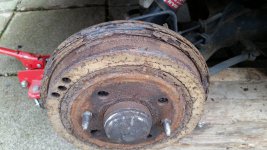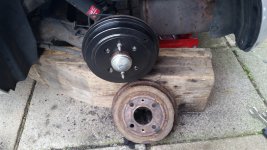I replaced my rear shocks today, no reason other than I'm doing all 4 corners at the moment and wanted a warmup easy job. While the back wheel was off I decided to check the condition of the drums/shoes. The drum/hub turns easily enough although there's a 'swish' suggesting it's not perfectly round inside - however I can't get the drum off. There was some kind of corrosion build up in the hub/drum/wheel area which even made removing the rear wheel harder than it should have been - I scraped away and wire burshed as much as I could but it looks like this stuff has fused the drum and hub together. Tried WD40 - nothing. Tried a rubber hammer - nothing. Tried a metal hammer - nothing.
Does anyone have any suggestions for dealing with this problem - is it common? Tempted to just take this issue to a garage. I saw another post about using some bolts where the wheel location studs fit but behind those it seems to be threaded too, I don't see how the bolt would do anything other than just make it even tighter?
Does anyone have any suggestions for dealing with this problem - is it common? Tempted to just take this issue to a garage. I saw another post about using some bolts where the wheel location studs fit but behind those it seems to be threaded too, I don't see how the bolt would do anything other than just make it even tighter?




